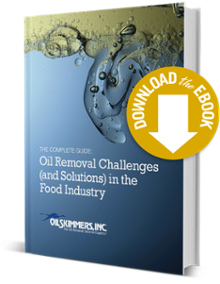 If you work in the food and beverage industry, you are
likely familiar with the challenges that fat, oil and grease (FOG) buildup presents and the
potential costly impact on your wastewater treatment processes and your bottom line.
If you work in the food and beverage industry, you are
likely familiar with the challenges that fat, oil and grease (FOG) buildup presents and the
potential costly impact on your wastewater treatment processes and your bottom line.
Removing FOG from water is an important problem to address in all segments of the industry. Oil ends up in wash water and wastewater in each of these applications:
- Farm Equipment - From washdown of machinery and facilities
- Oil extraction - Natural byproduct of the process
- Oil transport - Washing tank trucks
- Oil used for cooking or as an ingredient - Washdown of equipment and facilities
- Fat, oil and grease from meat and fish - Natural byproduct from processing
- Oil from manufacturing containers - Hydraulic oil from machinery
- Canning foods and beverages - Oil from can seamers
- Fat, oil and grease from cooking food for consumption - FOG builds up in grease traps
Learn more about the source of FOG in each of these situations by downloading our free resource, The Complete Guide: Oil Removal Challenges (and Solutions) in the Food Industry.
In the food industry, the question is likely not if you have oil in water, but where and to what extent the problem exists. Read on to learn about the kind of information our oil removal experts seek in order to assess oil-in-water applications and determine proper solutions.
Determining the Right Oil Removal Solution: 10 Considerations
To identify the problem and best solution for any oily water problem, our team at Oil Skimmers, Inc. conducts a short survey to identify the key characteristics of the application. Of the many details to consider when assessing an application, here are a list of 10 that are important to note:
- What is the path of the wastewater (Noting at which point oil meets water)?
- What is the volume of water used in the application?
- What is the estimated amount of oil and grease that enters the wastewater stream?
- To what extent is oil removal is necessary? (How clean or pure does the water need to be? Are there certain PPM requirements from the municipality?)
- Which processes and/or equipment are currently in place to address waste oil removal, and how well do they function?
- Are there any detergents included or added?
- Are there any solids in the wastewater?
- Is there any part of the wastewater flow that is oil-free or can be diverted to a separate flow?
- What is the first location at which the wastewater flow collects (tank, sump, pit, etc.)?
- What are the dimensions and volume of the tank, sump, or pit?
This is only a small example of they types of questions use when assessing an application and determining a proper solution. Download the guide to review a larger sampling.
How These Questions Inform the Solution
As these questions paint a picture of the application, it becomes evident the type of equipment required and where to best place it along the wastewater stream. Where possible, it is ideal to place oil removal equipment nearest to the location where the oil initially enters the water.
If the oil readily separates and rises to the surface of the water, an oil skimmer can be installed to continuously remove the oil and grease. If the oil is not currently separating or given an opportunity to separate and rise to the surface, an oil water separator with an integrated skimmer, like our SAS® Tank or Skim 1st Tank™, may be the most practical solution.
Learn More About Oil Removal Challenges in the Food Industry
For more information on the sources of FOG in the food and beverage industry, and to learn more about the real-world solutions we've provided in those applications, download The Complete Guide: Oil Removal Challenges (and Solutions) in the Food Industry.
